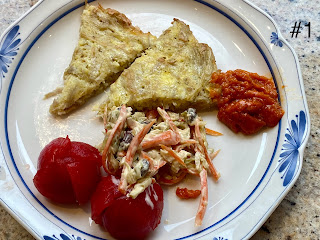About 3 years ago, at the recommendation of my wife’s sister who used to live in the Philadelphia area before moving to California, we stumbled across an old cookbook called “
Frog Commissary Cookbook”. In its hey day, this cookbook was a “must-have” especially in the Philadelphia area.
We completely forgot about this cookbook until a few days ago when my wife was looking through our blog for an “Appetizer” to make and she came across “
Salmon and scallop pâté”. We realized the recipe came from this cookbook. My wife quickly located the book and we started looking through the recipes. My wife found a few she would like to try. (You may expect to see them here at some later date.) We remembered that the salmon scallop pâté was quite good. So, I decided to make the pâté again but realized we did not have any scallops and we did not have any spinach to make the center layer. But we did have shrimp which I could substitute for the scallops and a cooked shittake mushroom/shallot mixture which I could substitute for the spinach used in the center of the pâté (#1B). Making the layers this way was much easier than the original recipe. I served the salmon shrimp pâté with a wedge of Myer lemon and leaf of arugula from our window sill veggie garden (#1).

In the original recipe, the center is spinach and scallop mousse (#1B). Although it looks nice it is more work than my current variation and the spinach didn’t really add much flavor. In terms of texture, the original salmon/scallop version was a bit softer. But the scallops basically only contributed to the texture not the taste; The main flavor was salmon. In my salmon/shrimp version, you definitely taste the shrimp.
Ingredients:
(The original recipe was essentially restaurant sized and too large for our home consumption. When I made it last time, I scaled it down to 1/4 of the original amount which made one small loaf of pâté. This time I essentially halved the original amount and made two loaves of pâté).
175 grams salmon, skin removed and cut into small cubes.
175 grams shrimp, shell removed and cut into small cubes.
1 whole egg (Original recipe called for just the egg white.)
120 ml cream (I used light cream, the amount of cream depends on the consistency of the mousse. You want a consistency that is not quite “pourable” but not too loose.)
salt, pepper, cayenne pepper (to taste)
14 ml brandy
(for the center layer)
4 tbs of minced and sautéed shiitake mushrooms (mostly chopped up stems) and shallots*
*When we get fresh shiitake mushrooms from Weee, I remove the stems and small caps and chop them up into small pieces. I sauté them in olive oil with finely chopped shallots seasoned with salt and pepper. This can be used in many other dishes such as meat balls, risotto etc. I put the remaining whole caps into a Ziploc bag with a paper towel. This keeps them fresh much longer than if left in the original packages.
Directions:
Add the salmon, shrimp, egg, and about the half of the cream into a food processor (I used a mini-food processor) and make a smooth mousse. Add more cream to get the right consistency and season the mixture.
(for the center layer)
Take 1/3 of the salmon shrimp mousse and add the shiitake-shallot mixture and blend well.
I made the pate in 2 small loaf pans (14x6.5x5cm) (I used a silicone pan. No need to oil or line it with a parchment paper). Fill the bottom of one of the the pans with 1/4 of the salmon-shrimp mousse and smooth the surface with a silicon spatula (#2 right) and top it with half of the mushroom mousse to form the center layer (#2 left). As was done with the bottom layer smooth the mushroom layer with the spatula. Add another 1/4 layer of the salmon-shrimp mousse to form the top layer and smooth the surface (#3). Repeat the process for the second pan. Cover the loaf pans with aluminum foil.
I preheated the oven (I used the toaster oven in a convection mode) to 350F.
I placed the loaf pans in a larger baking pan with a high rim. Poured hot water to the middle of the depth of the loaf pans (
bain-marie) and cooked for 35 minutes (internal temperature of 135F).
Un-mould and let it cool (#4).
Slice (#5) showing the center mushroom layer.
As far as I was concerned, this was as good as the original salmon-scallop pate. (My wife said she liked it better because in the original version the spinach layer didn’t “bring much flavor to the show”. In contrast the mushrooms in this version added a lot of complexity to the flavor which was very good. This version was also a bit firmer in texture and had a lovely shrimp flavor. The only mistake I made was salt. I pre-salted the mushroom mixture and also shrimp after thawing. All this accumulated and the pate was a lightly salty side for our taste but still extremely good. We had this without sauce or just with lemon juice which was all it needed.










































